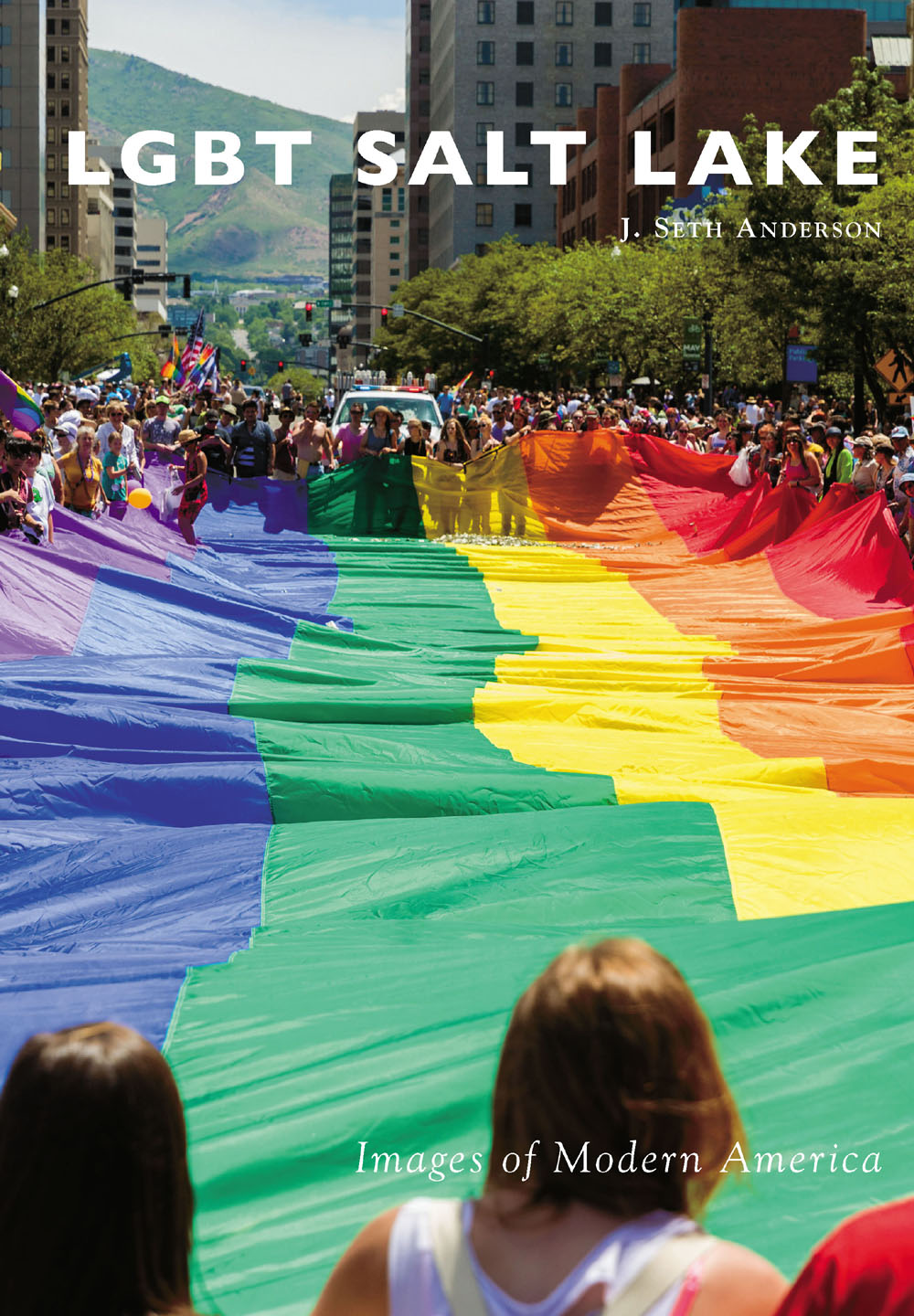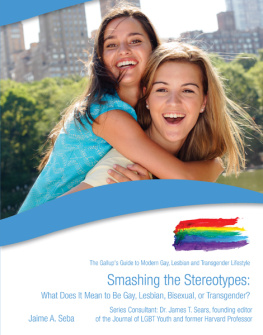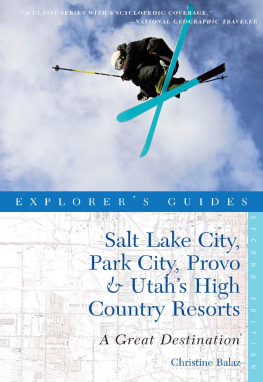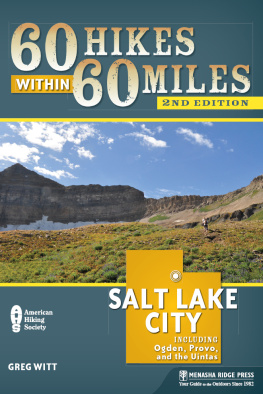
Images of Modern America
LGBT SALT LAKE

For the seventh year in a row, the LGBT community worked to pass a nondiscrimination bill that would have added sexual orientation and gender identity as a protected class from employment and housing discrimination. The LGBT community rallied at the state capitol in 2014 to show support for Sen. Steve Urquharts (R-St. George) bill, which the legislature refused to hear. (Courtesy David Daniels.)
FRONT COVER: Beginning in the 1970s, members of the gay and lesbian community began to gather in parks as part of Gay Pride Day, but in 1990, they took to the streets to march for the first time. From this modest beginning, when only several dozen lesbian, gay, bisexual, and transgender people marched through the streets of Salt Lake City proclaiming Gay Pride, the Pride celebration has grown to become the second-largest parade and festival in Utah, attracting thousands of people each June. (Courtesy David Daniels.)
UPPER BACK COVER: Members of Queer Nation march from the capitol building through the streets of downtown during the 1992 Gay Pride March in Salt Lake City. (Courtesy Curtis Jensen.)
LOWER BACK COVER: (left) The March on Washington in 1993 brought thousands of LGBT rights advocates from all over the country onto the National Mall. They called for government action on a variety of issues, including employment protections, the right to serve openly in the military, the repeal of sodomy laws, and more funding for HIV/AIDS education and treatment. LGBT rights activists from Utah joined the march. (Courtesy Curtis Jensen.) (center) The Bad Kids Collective formed in 2012 as a community of queer artists. They are performance artists who push boundaries on the ideas of drag, gender, and art. Their work resists conformity and helps create safe spaces for people who feel marginalized. (Courtesy Aaron Michael Woods; see .) (right) Queer Nation began in New York City in 1990. By February 1991, activists in Utah formed a chapter to promote queer visibility and to fight back against homophobia. Members deployed a language of liberation that harkened back to the days of the Gay Liberation Front. (Courtesy Curtis Jensen.)
Images of Modern America
LGBT SALT LAKE
J. SETH ANDERSON

Copyright 2017 by J. Seth Anderson
ISBN 978-1-4671-2585-7
Ebook ISBN 9781439660591
Published by Arcadia Publishing
Charleston, South Carolina
Library of Congress Control Number: 2017932975
For all general information, please contact Arcadia Publishing:
Telephone 843-853-2070
Fax 843-853-0044
E-mail
For customer service and orders:
Toll-Free 1-888-313-2665
Visit us on the Internet at www.arcadiapublishing.com
To the new and everlasting queers, for fulfilling the measure of their creation
CONTENTS
ACKNOWLEDGMENTS
I am forever grateful to so many people who have shaped my thinking, helped refine my scholarship, and encouraged me to continue my work. I must give a huge thanks to my graduate school advisor, Dr. Beth Clement, who took me under her wing and taught me how to read, write, and think like a historian. I thank Kathryn Stockton for her friendship and queer ideas and D. Michael Quinn for his research in the 1990s. Ben Williams must be thanked for his foresight in preserving dozens of boxes of primary sources pertaining to the gay and lesbian community in Utah, without which a project like this would be difficult to complete. Thanks go to Connell ODonovan for his research and ideas and to Doug Winkler for writing such a brilliant dissertation. I thank Brad Westwood at the state archives for having vision. I thank Dr. Kristen Ries and Maggie Snyder for their friendship and their heroic work treating people with AIDS when few others would. Kristen and Maggie deserve all the praise they get and more. Thanks go to all who contributed photographs for this project when I e-mailed out of the blue to ask for them. This includes Beano Solomon, Ben Barr, David Newkirk, Curtis Jensen, Scott Stites, Jolene Mewing, Courtney Moser, the Royal Court of the Golden Spike Empire, Scott McCoy, Becky Moss, Michael Aaron, and Stephen Justesen, to name only a few. I extend a huge thanks to David Daniels for documenting the movement in a postProp 8 world and for sharing his work with me. Thanks go to Nikki Boyer and Joe Redburn and to the LGBT community in Salt Lake City, who have supported this project and who turned over photographs and ephemera and shared their stories and experiences. Thanks go to Chris Schaefer and Doug Smith for their financial support. I also thank the staff at the J. Willard Marriott Library Special Collections at the University of Utah and Stacia Bannerman at Arcadia Publishing. Last but not least, I thank my husband, Dr. Michael Ferguson, who changed my life forever.
INTRODUCTION
Salt Lake City is a town full of secrets. Some secrets are hidden intentionally, while others are hidden in plain sight. One such secret is the history of the lesbian, gay, bisexual, and transgender communities in the city and the state. Long before culture had the language or concepts to identify sexual orientation and gender identity, people who we would now label as LGBT have called Utah home. Utah and Salt Lake City have a vibrant LGBT community, but the general public knows little about its history. Salt Lake City was not a gay metropolis like New York City or San Francisco, but by the 1970s, it was also not a small, rural town. Rather, the city occupied a space somewhere in the middle of these extremes. For some people, Salt Lake City felt provincial and a place from which they longed to escape. Yet others left their rural Utah towns for Salt Lake City, which they considered a big city in relation to where they had grown up. Brigham Young University also attracted a steady flow of young men and women to Utah County who traveled between Provo and Salt Lake City in search of others who shared their desires for love with a person of the same sex. Enough people moved into Salt Lake City after World War II that a small, urban gay subculture began to emerge. While Gay Liberation and organizations that would fight for the political rights of LGBT citizens were years away from forming, a small number of people in Salt Lake City recognized why they were different, often struggled to reconcile their sexual desires with their religious upbringings, and began to take small steps out of the closet.
By the late 1940s and early 1950s, several bars in town cautiously accepted the citys sexual minorities as customers. The Radio City Lounge opened at 147 South State Street in 1948 and within a decade became known as a bar where gay and lesbian people could meet in a relatively safe public space hidden beneath the heterosexual clientele. By the early 1950s, gays and lesbians began frequenting the Crystal Lounge at 174 South State Street. However, by 1957, the owners no longer welcomed gay and lesbian customers, because fear of exposure to law enforcement threatened the business. By the 1960s, the Tin Angel at 340 South State Street hosted female impersonation shows that drew a large crowd of straight-identified customers, which threatened to give away the secret (and safety) of gays and lesbians in Salt Lake City.
This book has two main purposes. The first aims to celebrate the history and people of Utah who worked for decades to establish a safer, kinder, and more just world for citizens who do not identify as heterosexual. Many of these efforts, from publishing the first gay and lesbian newsletters to confronting the devastating effects of AIDS and protecting the rights of LGBT youth, are heroic and must never be forgotten. The second purpose aims to shine a light on the historicity of what we now call the LGBT community in Utah. Unlike other sciences, the study of history is not esoteric. I do not believe professional historians have tried to obfuscate their work with confusing concepts or jargon in an effort to exclude everyone except other professionals from the study of sexuality in history. But the question becomes, how can one tune into the multiplicity of voices that have revealed in great depth the history of sexuality? How can one come to terms with the components of queer theory as well as issues of class, race, and gender analysis that shapes this field of study? How can one understand the debates and feel the excitement that comes from the creation of knowledge? I hope this book provides a helpful road map to people who may be unfamiliar with the history of sexuality but who are curious to learn how the LGBT community in Salt Lake City formed, how it defined itself, and the struggles and successes this movement has had over the decades.
Next page







